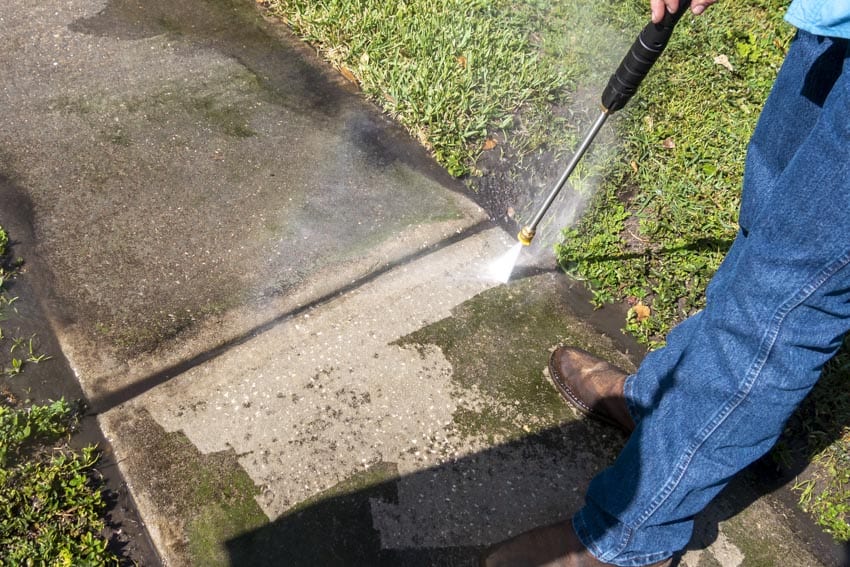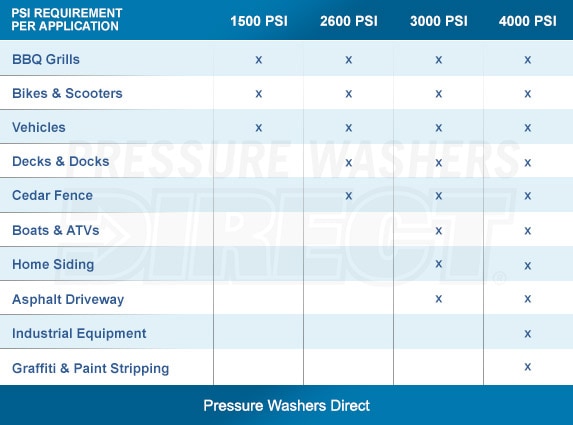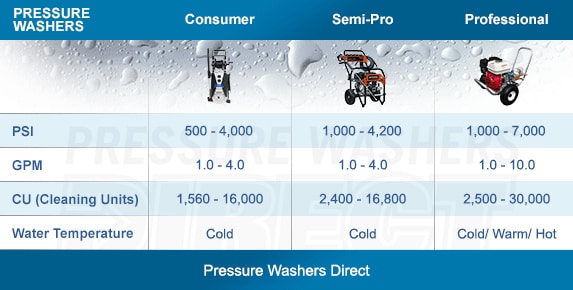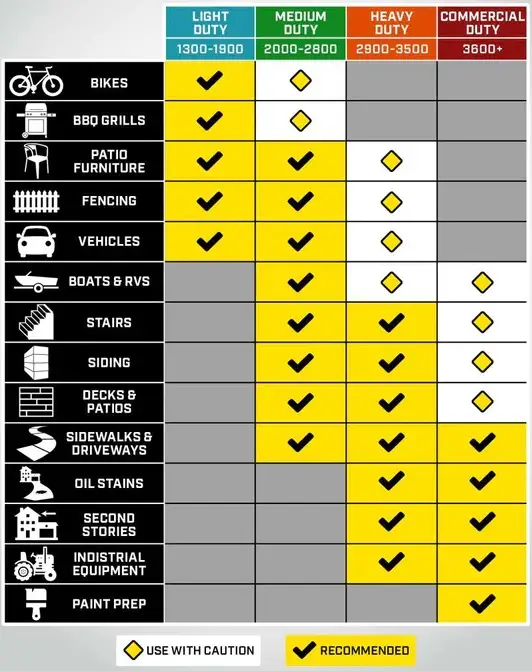Psi, or pounds per square inch, measures the pressure generated by a pressure washer. Higher PSI ratings indicate stronger cleaning power.
Understanding PSI in pressure washers is essential for effective cleaning. This measurement determines how forcefully water is ejected from the nozzle. A pressure washer with high PSI can tackle tough grime, dirt, and stains, making it ideal for surfaces like driveways and patios.
Conversely, lower PSI models are suitable for delicate tasks, such as washing cars or windows. Choosing the right PSI helps users achieve the desired results without damaging surfaces. Knowing the appropriate PSI for specific cleaning jobs ensures efficient use of time and resources, making your cleaning tasks more effective and enjoyable.
Page Contents
- 1 Introduction To Psi In Pressure Washers
- 2 Pressure Washers 101
- 3 Decoding Psi
- 4 Optimal Psi For Common Cleaning Tasks
- 5 Maximizing Cleaning Power
- 6 Psi And Water Consumption
- 7 Maintenance Tips For High-psi Washers
- 8 Choosing The Right Psi Washer
- 9 Conclusion: Psi’s Impact On Cleaning Efficiency
- 10 Frequently Asked Questions
- 11 Conclusion
Introduction To Psi In Pressure Washers
Psi stands for pounds per square inch. It measures the pressure a pressure washer can generate. Higher psi means stronger cleaning power. This is vital for removing dirt and grime effectively.
Different tasks require different psi levels. For example, light cleaning needs around 1300-1900 psi. Medium cleaning tasks, like washing cars, need 2000-2800 psi. For heavy-duty jobs, such as cleaning driveways, 2900 psi or more is best.
| Task | Recommended Psi |
|---|---|
| Light Cleaning | 1300-1900 psi |
| Medium Cleaning | 2000-2800 psi |
| Heavy-Duty Cleaning | 2900+ psi |

Credit: www.protoolreviews.com
Pressure Washers 101
Pressure washers use PSI to measure cleaning power. PSI stands for pounds per square inch. It indicates the water pressure delivered by the washer. Higher PSI means more forceful water spray.
Components of a pressure washer include the motor, pump, and nozzle. Each part affects the overall performance. The motor powers the pump, which creates pressure. The nozzle controls the spray pattern.
PSI greatly influences washing tasks. For light jobs, like washing cars, a PSI of 1300-1900 is enough. Heavy tasks, like removing paint, require PSI between 2500-3000. Always choose the right PSI for your cleaning needs.
Decoding Psi
Psi stands for Pounds per Square Inch. It measures the pressure of water in a pressure washer. Higher psi means more power. This helps to clean surfaces better.
The science behind pressure and flow is simple. Pressure pushes water out forcefully. Flow rate measures how much water comes out. Together, they determine cleaning effectiveness.
For most tasks, a higher psi is better. However, using too much pressure can damage surfaces. Choosing the right psi is key for safe cleaning.
| Surface Type | Recommended Psi |
|---|---|
| Wood | 500-800 psi |
| Concrete | 2500-3000 psi |
| Cars | 1200-1900 psi |
Optimal Psi For Common Cleaning Tasks
The optimal psi for residential cleaning tasks usually ranges from 1300 to 1900 psi. This level is perfect for cleaning patios, decking, and siding. For light tasks, like washing cars, 1600 psi is often sufficient. Vinyl siding can be cleaned effectively with 1500 psi.
Commercial cleaning standards require higher psi levels. A range of 2000 to 3000 psi is common for heavy-duty jobs. This is ideal for cleaning driveways, parking lots, and industrial equipment. Paint removal may need up to 3000 psi. Using the right psi ensures effective cleaning without damage.
| Task | Optimal Psi |
|---|---|
| Car Washing | 1600 psi |
| Vinyl Siding | 1500 psi |
| Driveway Cleaning | 2000-3000 psi |
| Paint Removal | Up to 3000 psi |
Maximizing Cleaning Power
To maximize cleaning power, adjusting the Psi is key. Higher Psi levels help remove tough stains. For stubborn stains, start with a medium Psi setting. Test a small area first to avoid damage. Increase the Psi gradually if needed.
Using high Psi requires safety measures. Always wear protective gear like goggles and gloves. Keep a safe distance from surfaces. Avoid pointing the nozzle at people or pets. Never use high Psi on delicate materials.
Psi And Water Consumption
Understanding PSI is important for pressure washing. High PSI means more power. This can clean tough dirt easily. However, it also uses more water. Balancing efficiency and water use is key.
To save water, consider these tips:
- Choose a pressure washer with lower PSI for light jobs.
- Use a nozzle that matches your cleaning task.
- Wash during cooler times to avoid evaporation.
- Recycle used water for other tasks.
These steps help reduce water waste. Enjoy effective cleaning while being eco-friendly!
Maintenance Tips For High-psi Washers
Regular maintenance is key for high-psi washers. Clean the filter every month to prevent clogs. Check the hoses for cracks or wear. Replace damaged parts to ensure safety.
Keep the nozzle clean for proper water flow. Use soap designed for pressure washers. This helps remove dirt effectively. Store the washer in a dry place to avoid rust.
Common psi-related issues include low pressure or uneven spray. Check the water supply for adequate flow. A clogged nozzle may cause uneven spray. Remove and clean it as needed.
Inspect the pressure gauge regularly. It helps track the washer’s performance. If pressure is too low, examine the pump for issues.

Credit: www.pressurewashersdirect.com
Choosing The Right Psi Washer
Choosing the right Psi washer can make cleaning easier. Psi stands for pounds per square inch. Higher Psi ratings mean more cleaning power. It is essential to match the Psi to your cleaning needs.
Factors to consider include:
- Surface type: Different surfaces require different pressure levels.
- Cleaning tasks: Identify what you plan to clean.
- Water flow rate: Measured in gallons per minute (GPM), it affects efficiency.
- Weight and portability: Ensure it’s easy to move and store.
| Model | Psi Rating |
|---|---|
| Model A | 2000 Psi |
| Model B | 3000 Psi |
| Model C | 4000 Psi |
Conclusion: Psi’s Impact On Cleaning Efficiency
Psi stands for pounds per square inch. It measures the pressure of water in a pressure washer. A higher psi means more cleaning power. This allows for better removal of dirt and grime. Choosing the right psi is crucial for different surfaces.
For delicate surfaces, a lower psi is ideal. On tougher surfaces, a higher psi works best. Understanding psi helps users select the right washer for their needs.
| Surface Type | Recommended Psi |
|---|---|
| Wood | 1200-1500 psi |
| Concrete | 3000-4000 psi |
| Cars | 1500-2000 psi |
Future pressure washers may feature smart technology. These advancements will improve cleaning efficiency. Users can expect better energy use and water conservation. Innovations will also focus on user safety and convenience.

Credit: www.pressurewashersdirect.com
Frequently Asked Questions
What Does Psi Mean In Pressure Washers?
PSI stands for “Pounds per Square Inch. ” It measures the pressure output of a pressure washer. Higher PSI means more cleaning power, making it effective for tough jobs. Understanding PSI helps you choose the right pressure washer for your specific cleaning needs.
How Much Psi Do I Need For Home Use?
For typical home cleaning tasks, 1300 to 1900 PSI is sufficient. This range effectively handles chores like washing cars and decks. For more stubborn stains, consider a pressure washer with 2000 PSI or higher. Always match the PSI to the job for optimal results.
Is Higher Psi Always Better?
Not necessarily. Higher PSI provides more cleaning power but can damage delicate surfaces. It’s essential to select the right PSI based on the surface being cleaned. Always refer to manufacturer guidelines to avoid causing any damage while cleaning.
What Is The Difference Between Psi And Gpm?
PSI measures pressure, while GPM stands for “Gallons per Minute,” measuring water flow. Both are crucial for effective cleaning. Higher PSI removes dirt, while higher GPM rinses away grime. A balanced combination of both ensures efficient and effective cleaning performance.
Conclusion
Understanding PSI in pressure washers is crucial for choosing the right machine for your needs. Higher PSI means more cleaning power, but it’s essential to match it with the appropriate nozzle and technique. This knowledge will help you achieve effective cleaning results while protecting your surfaces.
Make an informed choice for your next project.

